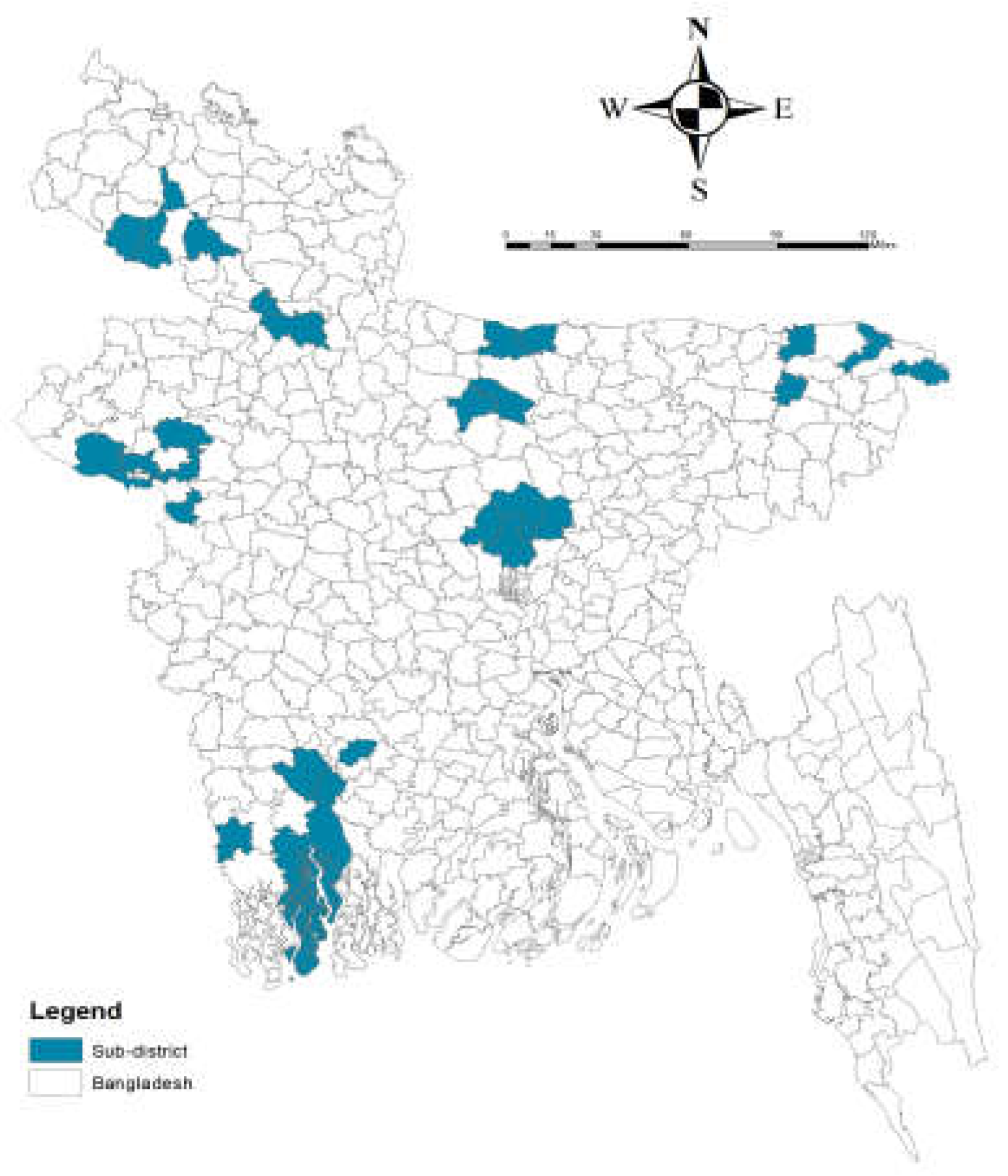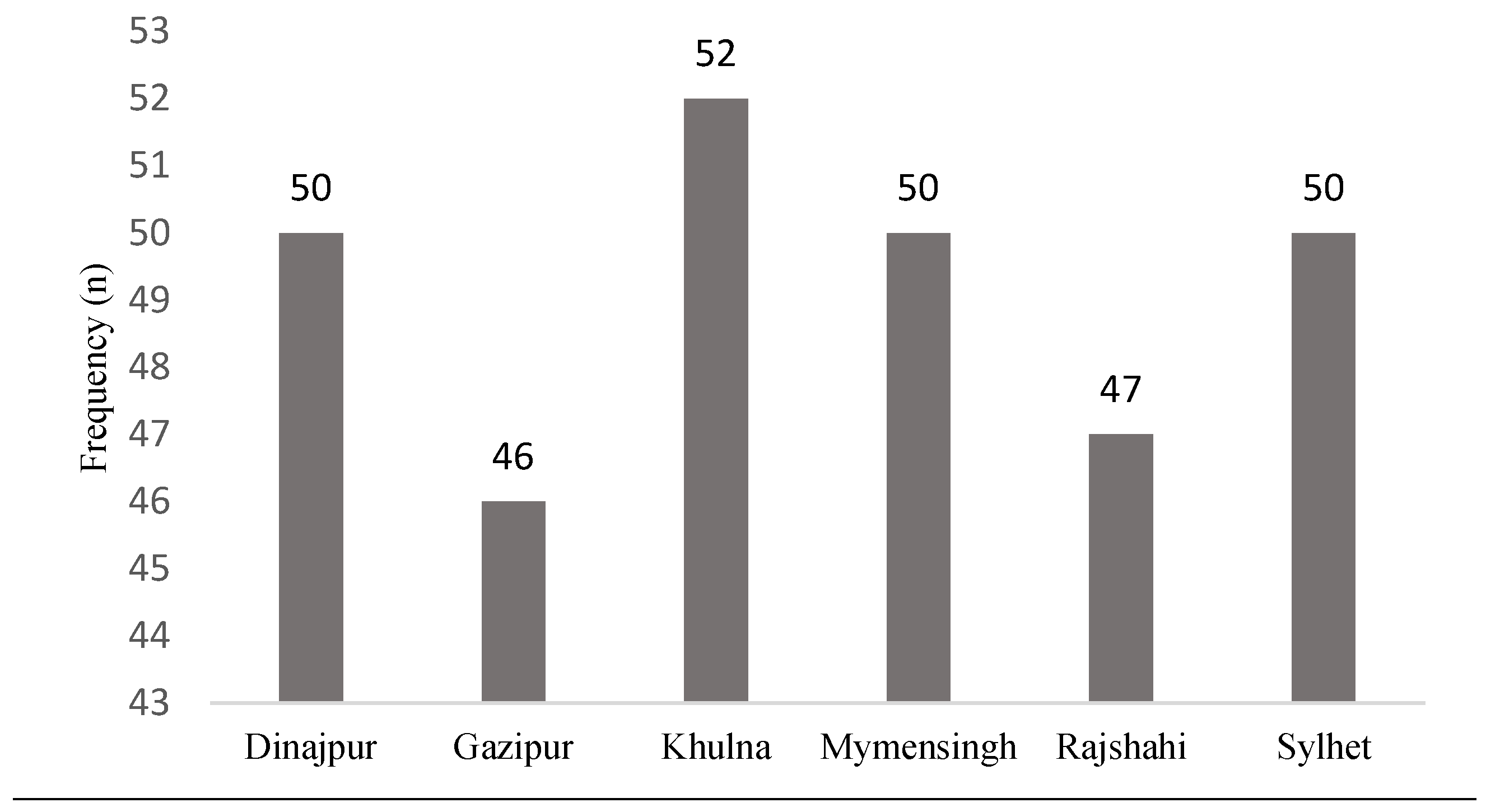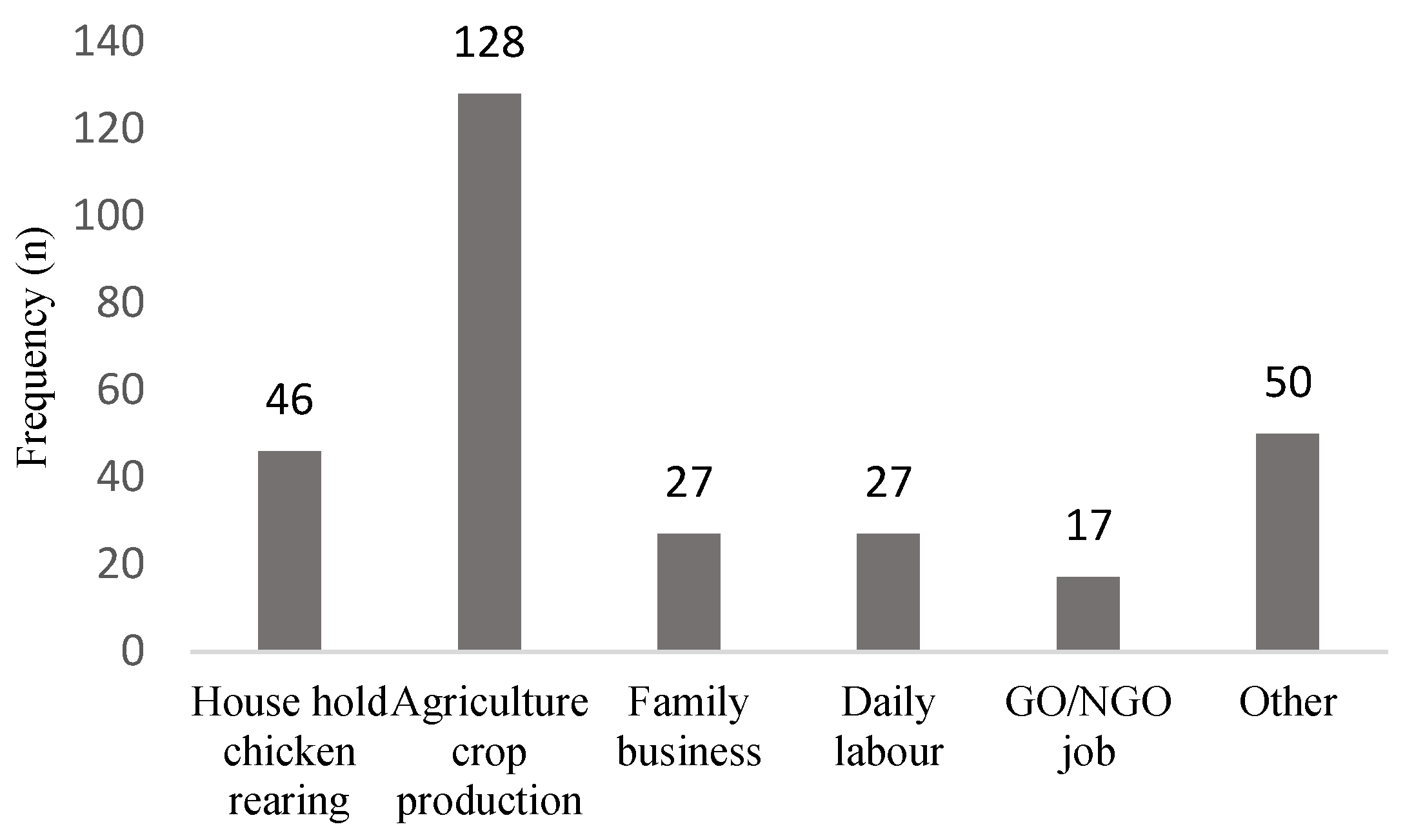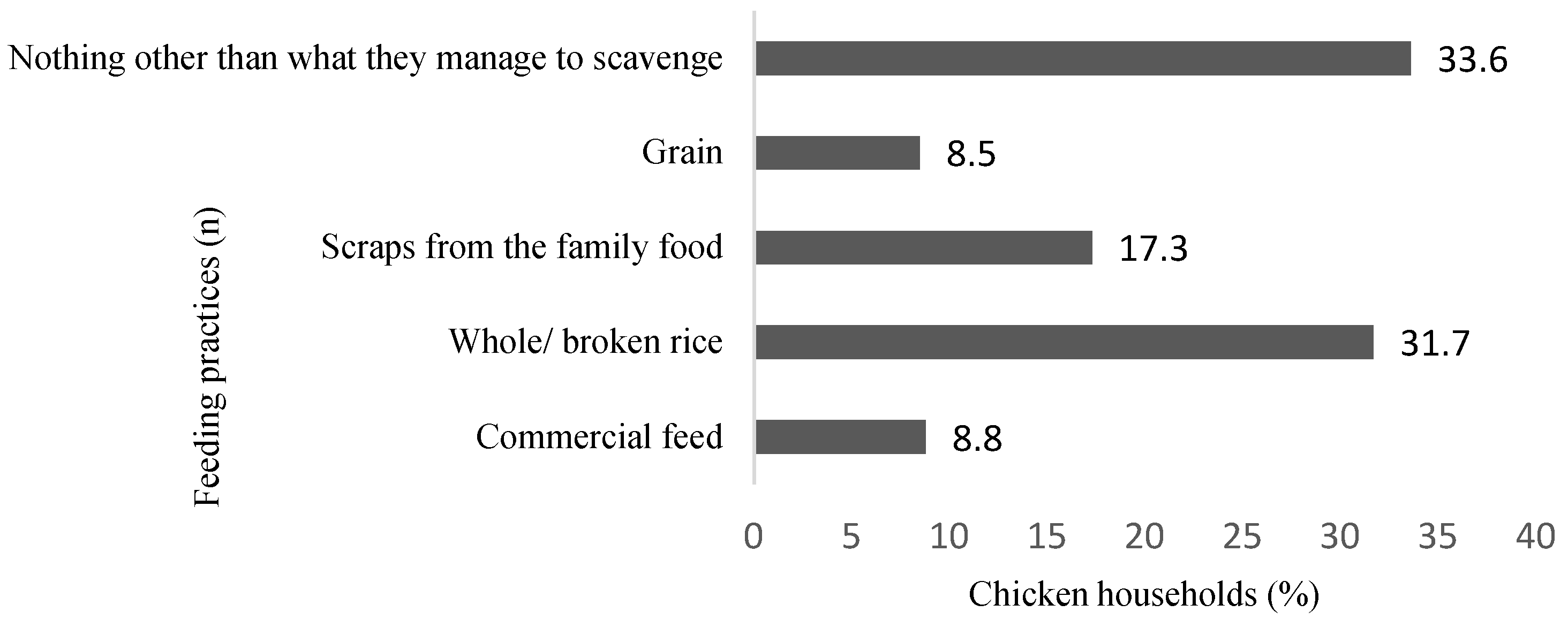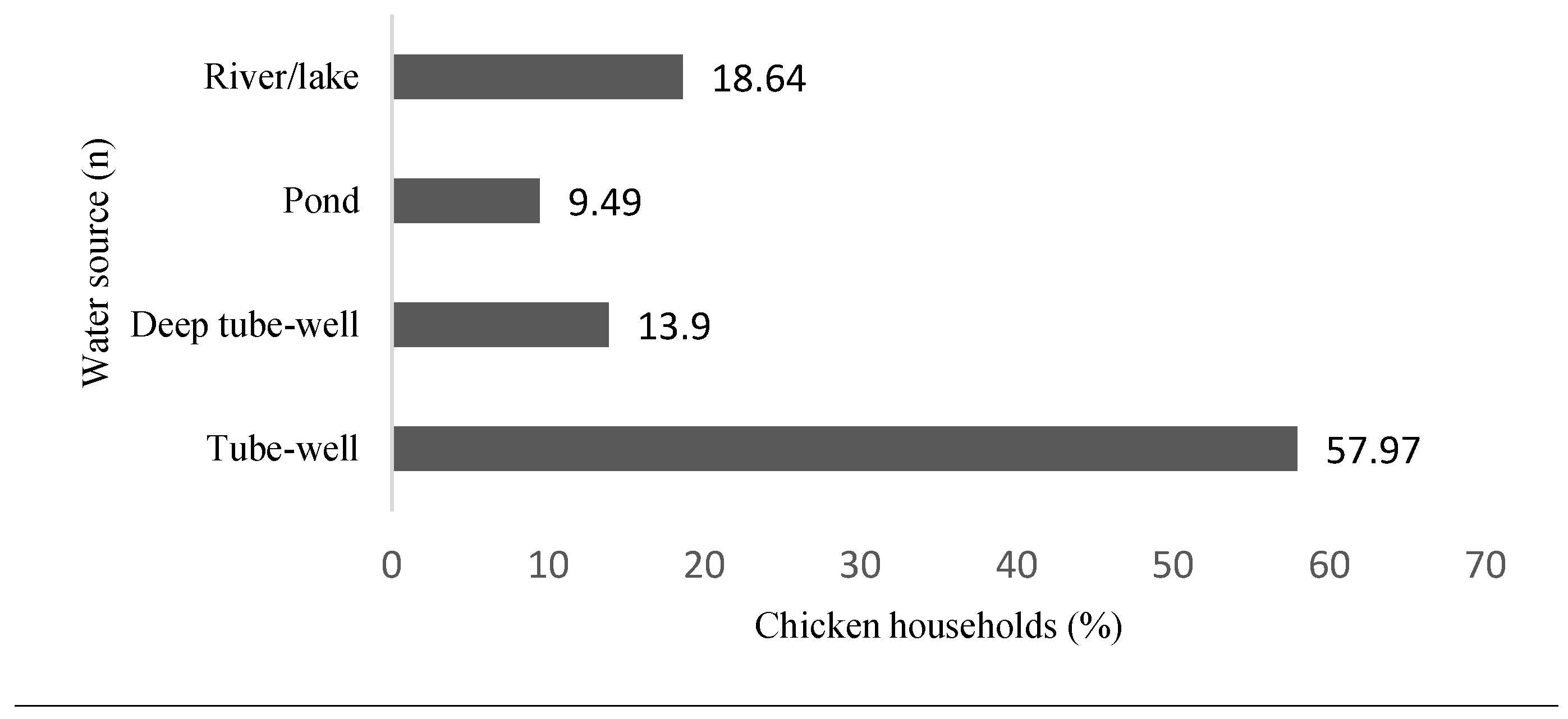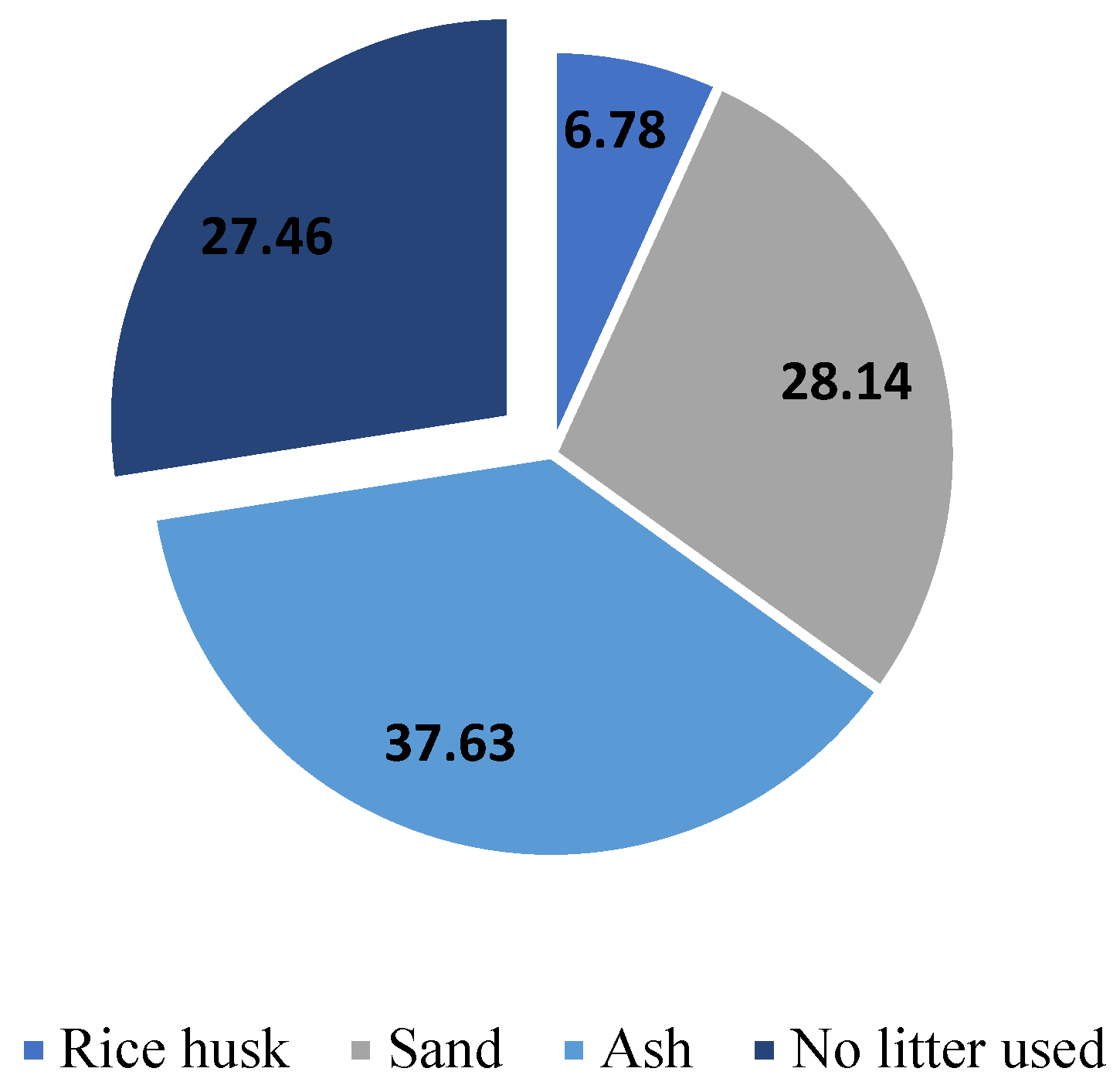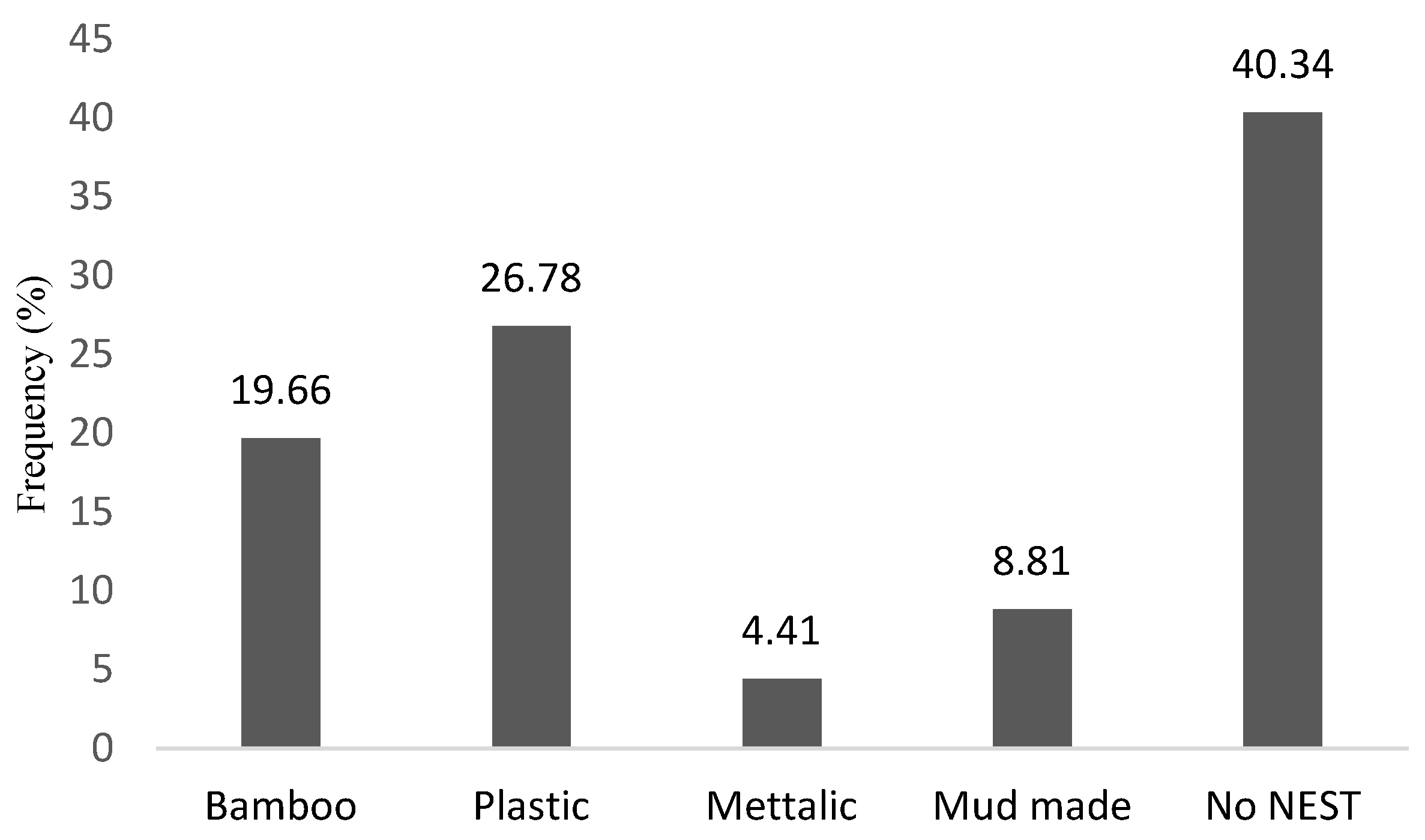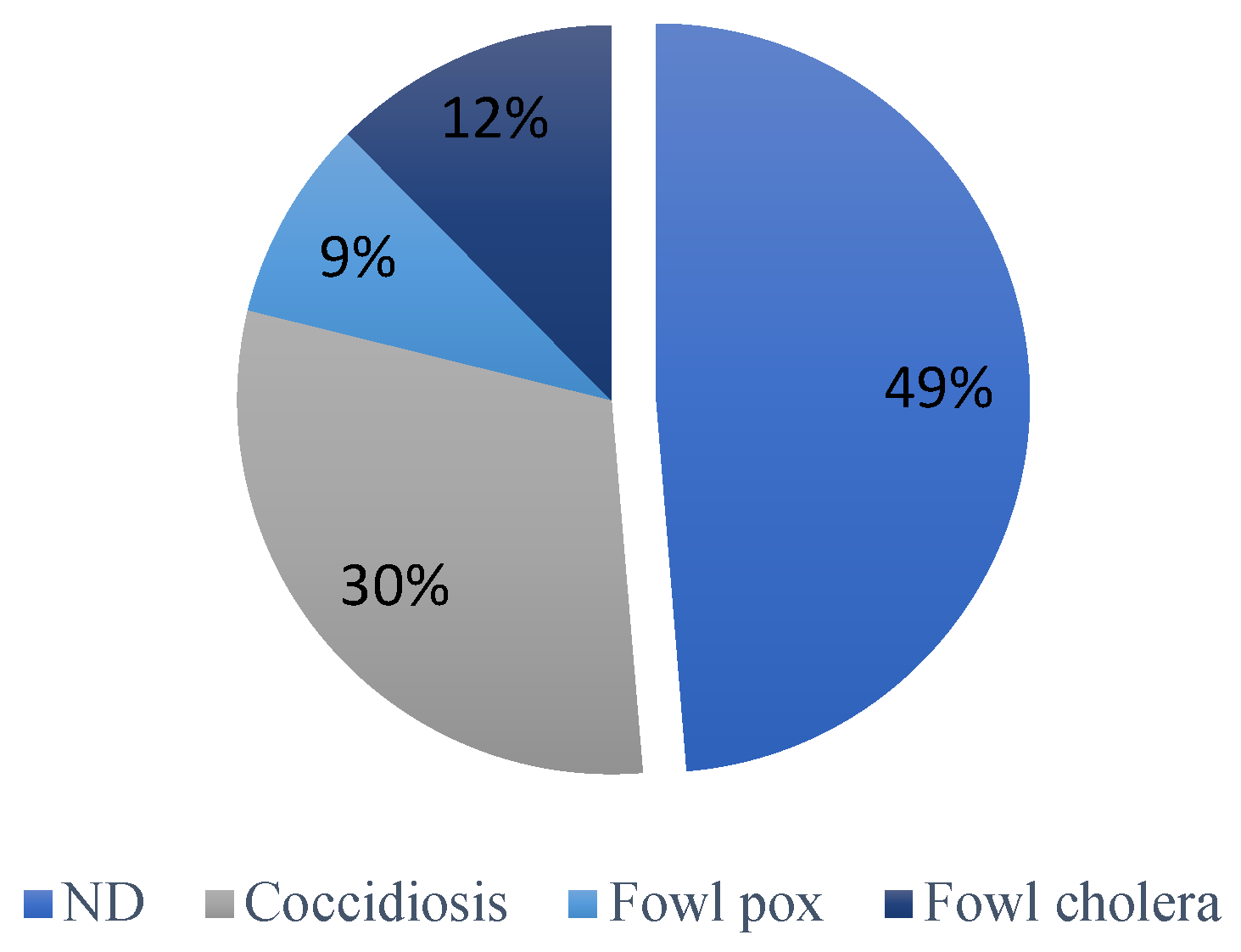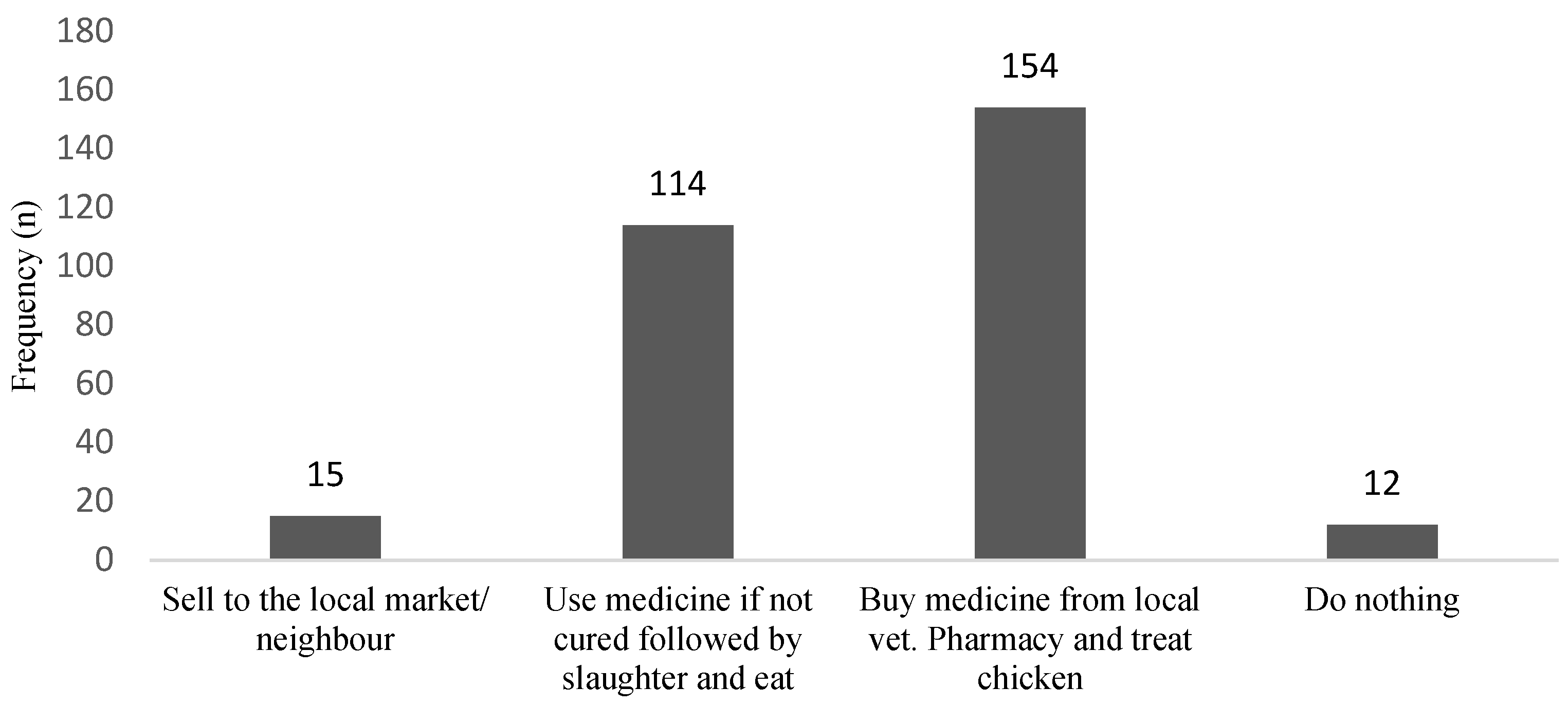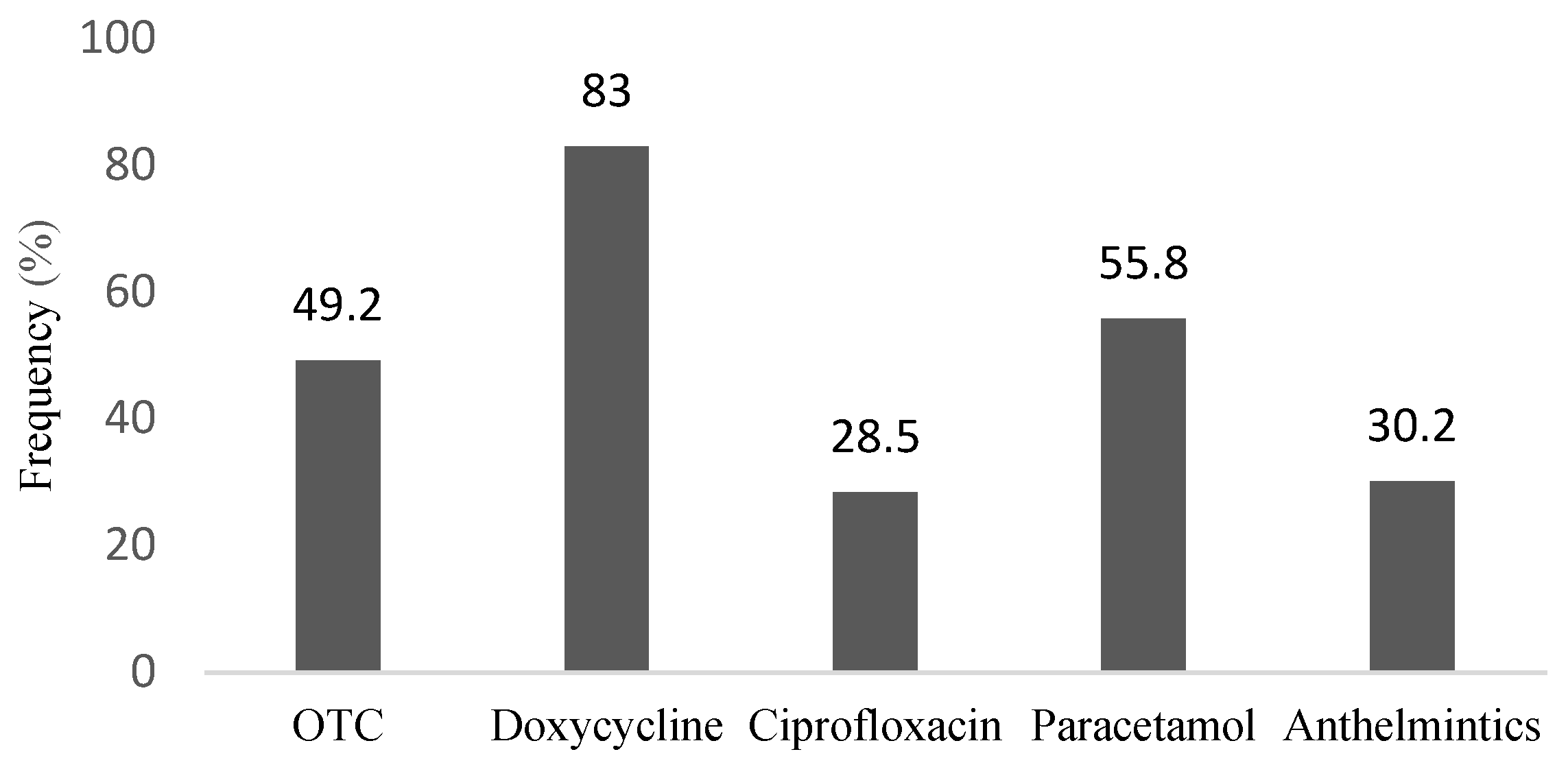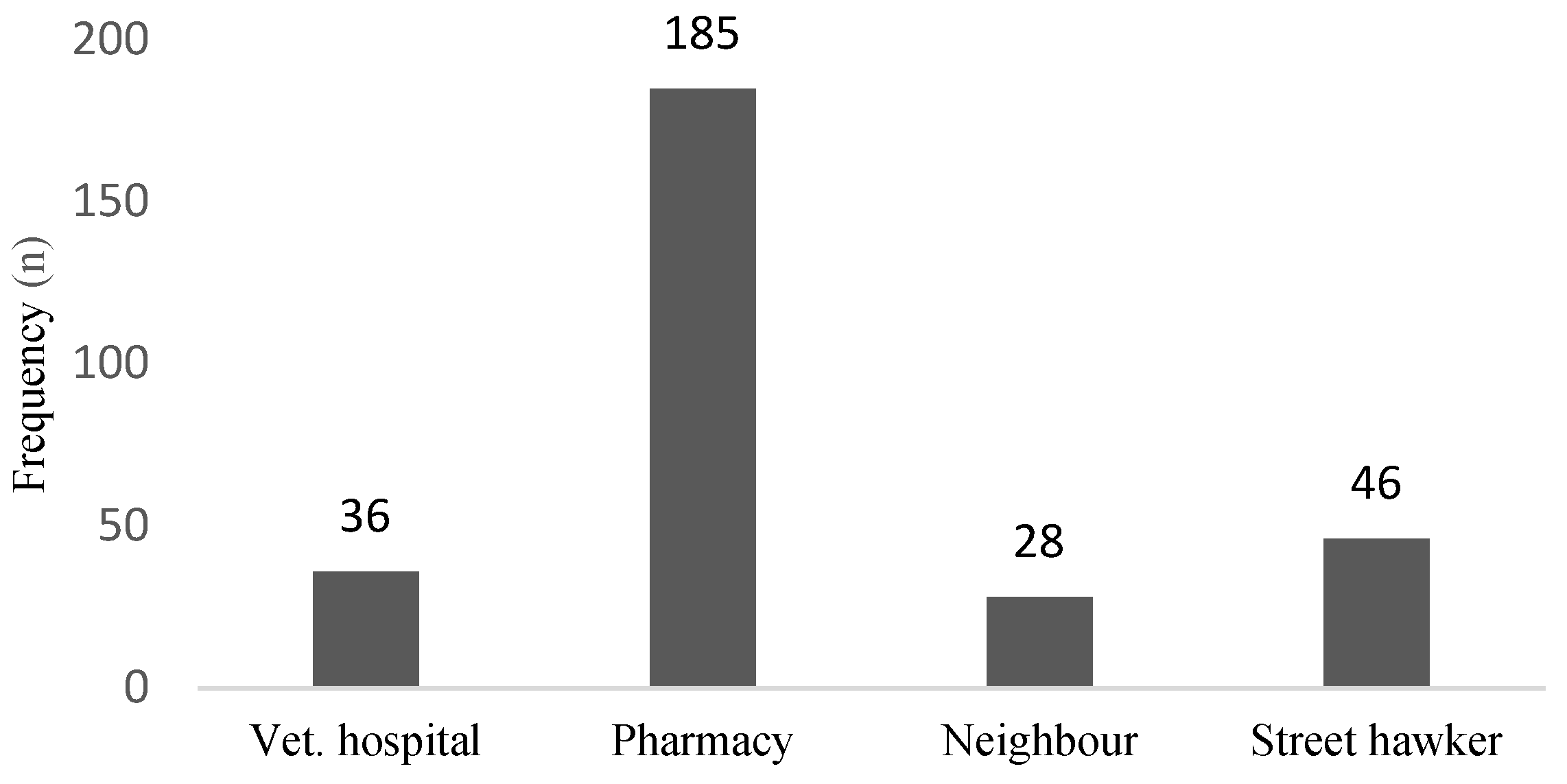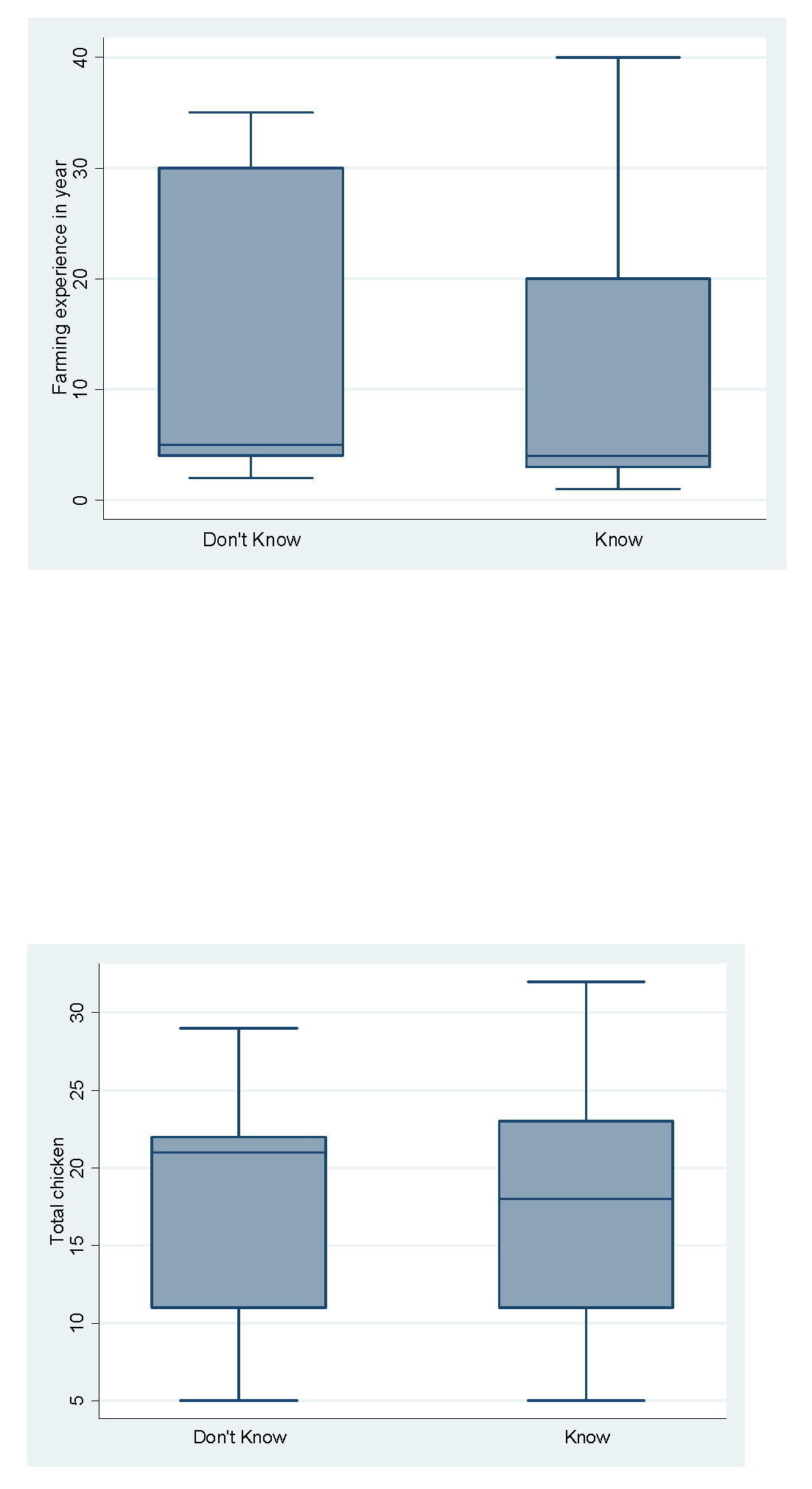1. Introduction:
The Bangladesh poultry subsector, which includes a total of 375 million poultry and between 90000 and 100000 commercial farms and is supported by 610 animal health companies, 30 pharmaceuticals, 18 grandparents, 299 parents, 84 hatcheries, and 293 registered feed mills (Hamid et al., 2017; Rahman et al., 2017b; BPICC, 2022; DLS, 2022b; WPSA-BB, 2022; AHCAB, 2022). It is a vital piece of Bangladesh's agricultural system and has resulted in the creation of 20 % of direct jobs as well as 50 % of indirect jobs and support services (DLS, 2022). According to the Department of Livestock Services (DLS) report in 2022, the slaughtering of chickens and other fowl contributes to 37% of the total meat production in Bangladesh. Furthermore, the poultry industry has been able to exceed the national demand by providing 136 eggs/head/year (DLS, 2022a). In Bangladesh, the production of poultry is carried out using a variety of methods, including traditional rural backyard scavenging, semi-scavenging, commercial credit, cash, as well as contracted or integrated farming (BPICC, 2022). Before the advent of industrialization in Bangladesh, backyard poultry farming was the primary source of poultry meat and egg, with most of the products used to meet the household needs of the producers (Hamid et al., 2017). Nowadays backyard chicken farming is also an integral part of the economy in Bangladesh and serves as a vital source of income for many rural households, where over 90% of the poultry population is raised in backyard systems (Shahjahan et al., 2011). Backyard chickens not only provide a source of protein and income, but they also act as a kind of savings and a safety net for families in times of need (Alam et al., 2014; Sultana et al., 2012). However, backyard chicken farming in Bangladesh is characterized by poor management practices, low levels of biosecurity, and high rates of disease (Asaduzzanab, 2018).
Proper management practices are vital for maintaining the health and productivity of backyard chickens. Backyard chickens require adequate housing facilities, proper feeding, clean water, and regular vaccination against common poultry diseases to thrive (Shanta et al., 2017; Conan et al., 2012). Biosecurity is also an important consideration in backyard chicken raising, as it plays an important role in avoiding disease transmission between flocks. Farmers in Bangladesh are unaware of the concept of biosecurity and its significance (Conan et al., 2012). This is aggravated by the fact that many farmers lack the resources to execute basic biosecurity procedures, such as quarantine of new birds, disinfection of equipment, and restrictions on visitors and outside equipment (Rahman et al., 2017). The disease is a major problem in backyard chicken farming, and it can have serious ramifications for both the birds' health and the farmers' livelihoods. The disease can spread rapidly within a flock, leading to reduced productivity and mortality, which can have a significant impact on the income of small-scale farmers who depend on their chickens for their livelihoods. Newcastle disease, fowl cholera, avian influenza, and coccidiosis are among the most frequent diseases found in backyard chickens in Bangladesh (Barua and Yashimura, 1997; Popy et al., 2018). One of the biggest challenges with sick birds is the risk of disease transmission to the rest of the flock. This can lead to the rapid spread of disease and even result in the death of the entire flock. Additionally, sick birds have lower egg-laying rates, which reduces the number of eggs available for consumption or sale. This can impact the economic stability of small-scale farmers, who rely on their chickens for food and income.
In Bangladesh, the use of medicines to treat sick birds is common. According to a study by Hicks et al. (2021) on the use of drugs in backyard chicken farming in Bangladesh, Doxycycline and Oxytetracycline were commonly used antibiotics to treat sick chickens. The study also found that Doxycycline, Oxytetracycline, and Ciprofloxacin were used (Hicks et al., 2021). Another study by Ferdous et al. (2019) revealed that Oxytetracycline, Doxycycline, and Enrofloxacin were the most used antibiotics in backyard chicken farming in Bangladesh. The study also found that farmers often used antibiotics as a prophylactic measure, rather than treating sick birds only. Furthermore, many farmers rely on self-medication or seek assistance from inexperienced individuals (Islam et al., 2012). This technique can lead to drug misuse and overuse, which can be harmful to both animal and human health, such as the development of antimicrobial resistance (AMR).
Proper management practices, such as improving biosecurity, implementing vaccination programs, and providing adequate nutrition and housing, can help prevent disease outbreaks and reduce the need for antibiotics in backyard chicken farming. Given the importance of backyard chicken farming in Bangladesh, it is critical to evaluate farmers' management, biosecurity, and disease knowledge, attitudes, and practices (KAP). This research intends to close this gap by analyzing the KAP of backyard chicken farmers in rural Bangladesh and identifying the associated factors that influence biosecurity and management practices. The study's specific objectives are to: (1) assess backyard chicken farmers' knowledge and practice concerning management and biosecurity, and (2) identify factors that evaluate backyard chicken farmers' biosecurity knowledge and practices. To accomplish these goals, the multivariate analysis will be utilized to assess the link between the binary response variable "Do you know the word biosecurity?" and other variables. Knowing the KAP of backyard poultry farmers can help guide the creation of focused interventions to improve management methods, boost biosecurity, and lower disease incidence. This research can help to establish policies and initiatives to encourage sustainable backyard chicken raising in Bangladesh by knowing the biosecurity knowledge of backyard chicken farmers.
2. Methodology:
2.1. Sampling Method and Survey Location:
A total of 295 household samples were collected and analyzed for the study. The study aimed to provide an accurate representation of the backyard chicken population and management practices in the study area. The study collected backyard chicken households’ data from 36 sub-districts in six divisions (Dhaka, Sylhet, Khulna, Rajshahi, Rangpur, and Mymensing) among eight divisions in Bangladesh, covering only rural areas. To ensure maximum coverage of the area, the study used a convenient sampling technique to choose the divisions, then the districts, and finally five sub-districts from each district. Firstly, the total number of backyard chicken households in each sub-district was collected from the study District livestock office. This chicken households ‘number was divided by the total sample size for each division, and the required sample size for each sub-district was obtained. The union, village, and ward were randomly sampled from the sub-district, the union, and the village, respectively. Each union's livestock service provider (LSP) was engaged for assistance in visiting the houses. The survey was conducted by starting from the beginning of the village and selecting households randomly, which had at least five or more chickens. The LSPs were asked how many households in the village kept backyard chickens and were given a random number of households from which to select. Only the randomly selected households were subsequently visited.
2.2. Questionnaire and data collection
This study's questionnaire was developed to collect data on four major areas: socioeconomic situations, biosecurity, and disease information of backyard chicken households. It was designed in English and then translated into Bengali. The questionnaire was pre-tested on a sample of 12 randomly selected chicken households in six divisions of Bangladesh to validate and improve its content and structure. The pre-test results were evaluated to revise the questionnaire to ensure that it was thorough and applicable to the targeted respondents. The questionnaire included closed, semi-closed, and open-ended questions, allowing for more detailed and specific responses. The objective of the closed questions was to collect basic demographic data and analyze the present level of biosecurity practices and disease prevalence in backyard poultry farming in the study region. The open-ended questions were designed to elicit more in-depth information on specific concerns, allowing respondents to share more in-depth insights into their farming techniques and difficulties. Before beginning the interview, the first cohort of the Field Epidemiology Training Program for Veterinarians (FETPV) fellows provided written consent and was told of the goal of the study, the confidentiality of their responses, and their right to withdraw from the study at any time. Each interview lasted roughly forty minutes. The questionnaire and interview were developed to guarantee that the data collected was precise and reliable, while also respecting the confidentiality and cultural norms of the participants.
2.3. Data management and analysis:
In this study, the relationship between farmers' familiarity with the word “biosecurity” and their biosecurity practices in backyard chicken farming in Bangladesh was assessed. Data from each of the six FETPV fellows were gathered and cleaned in Microsoft Excel 2010, followed by coding and recoding of the data for further analysis. The cleaned data were input into STATA/SE-13 for further analysis. Descriptive analysis was conducted to summarize the demographic data and distribution of different biosecurity and management practices, diseases, and drugs using data from the backyard chicken farmers of the study area. Column graphs, pie charts, and other graphical presentations were used to represent the results. Univariate analysis was performed using the chi-square or exact test to evaluate the relationship between the binary response variable (Do you know the word biosecurity? Yes/No) and other variables. Variables with a p-value of less than or equal to 0.1 were included in the multivariate logistic regression model. The multivariate logistic regression model was developed based on the significant variables identified in the univariate analysis (Chi-square/ Exact test). Collinearity between the variables was assessed using the variance-covariance matrix estimates. For variables that were highly correlated, one of the variables was included in the model-building process. A stepwise approach was used to eliminate variables that did not significantly contribute to the model. For the factor variables, the regression coefficients were presented as an odds ratio (OR), a p-value, and a 95% confidence interval. We assessed the goodness of fit test of the model using Hosmer-Lemeshow tests. We evaluated the reliability of the model using the receiver operating curve plot. Factor variables with
P-values ≤0.05 were retained in the final model. All analyses were conducted using STATA 14.0 (StataCorp, College Station, TX). Google maps (
https://www.google.com.bd/maps) was used to get the study area of data collection. ArcGIS-ArcMap version 10.2 (ESRI, USA) was used to produce a map.
3. Results
3.1. Distribution of backyard chicken households by districts and sub-districts
The survey was conducted in six distinct districts of six different divisions of Bangladesh (
Figure 1), with Khulna district having the highest frequency of 52, followed by Dinajpur and Sylhet with 50 each, Gazipur with 46, and Rajshahi with 47 (
Figure 2).
3.2. Distribution of backyard chicken households by Source of income
Most backyard chicken farmers in Bangladesh (128 households) rely on agricultural crop production as their primary source of income, while household chicken farming is less frequent (46 households). Other sources of income, such as a family business, daily labor, a job with an NGO or GO, and others, are present but less notable
(Figure 3).
3.3. Distribution of backyard chicken households by feeding practices
Most backyard chicken households in Bangladesh fed their chickens whole or broken rice (31.7% of households) or leftover food scraps (17.3% of households). A substantial proportion of households (33.6%) revealed that their chickens scavenge for their food. The use of commercial feed was very low (8.8%) (
Figure 4).
3.4. Distribution of backyard chicken households by water source
The study investigated the distribution of water supplies for backyard poultry households in Bangladesh. The results indicated that tube wells were the most prevalent water source, with 57.97% of households adopting them. Moreover, river/lake (18.64%) and deep tube wells (13.9%) were utilized frequently. Comparatively, the reliance on ponds as a source of water was quite low (9.49%) (
Figure 5).
3.5. Distribution of backyard chicken households by litter used
Ash (37.63%) and sand (28.14%) were the most prevalent types of litter, according to the findings. 6.78 % of households reported using rice husk, and 27.46% reported using no litter at all in backyard chicken farming (
Figure 6).
3.6. Distribution of backyard chicken households by NEST BOX used
Results showed that a significant proportion of households (40.34%) did not use any nest box at all. Among those who did, plastic (26.78%) and bamboo (19.66%) were the most commonly used materials. Mud-made nest boxes were used by almost 9 % of households, while metallic ones were used by only 4.41% (
Figure 7).
3.7. Distribution of backyard chicken households by diseases
The highest frequent disease was Newcastle disease (49 %), followed by coccidiosis (30 %), fowl cholera (12 %), and fowl pox (9 %). (
Figure 8).
3.8. Distribution of backyard chicken households by consequences of sick birds’
The majority of households (n=154) treated sick chickens with medication acquired from local veterinary pharmacies, while 114 farmers slaughtered and consumed chickens that were sick. A very small number of households (n=15) sold sick chickens to the local market or neighbors, and an even smaller percentage (n=12) did nothing about the sick birds (
Fig 3.9).
3.9. Distribution of backyard chicken households by drug using
The results showed that 83% of households used Doxycycline, a broad-spectrum antibiotic, to treat sick chickens, while 49.2% used Oxytetracycline (OTC). Paracetamol, a pain reliever, was used by 55.8% of households. Ciprofloxacin, another antibiotic, was used by 28.5% of households, and 30.2% used anthelmintic to control internal parasites (
Figure 10).
3.10. Distribution of backyard chicken households by drug source
Most drug sources for backyard chicken farmers in Bangladesh were pharmacies (185) followed by street hawkers (46) and veterinary hospitals (36). A smaller proportion obtained drugs from neighbors (28) (
Figure 11).
3.11. Distribution of backyard chicken households by farming experience and chicken number
The box plot graph (
Figure 12) depicts the distribution of farming experience and the number of chickens among backyard chicken farmers who are either familiar with or unfamiliar with the word biosecurity. The x-axis depicts the two kinds of farmers, "familiar" and "unfamiliar," while the y-axis reflects experience in years and the number of chickens raised. The box plot illustrates the median, interquartile range, and range of each category's data. In general, farmers who were familiar with biosecurity had similar experience (median quartile; 3 years vs. 4 years) and dissimilarity in chicken rearing numbers (median quartile; 18 vs. 21) than those who were unfamiliar with the word.
3.12. Univariate association
The table displays the findings of the univariate association between "biosecurity" knowledge and significant variables with a p-value of less than or equal to 0.1, as calculated by a chi-square or exact test. The frequency and percentage of individuals who knew the term "biosecurity" for each of the key factors are provided in the table. These variables were therefore forwarded to construct the multivariate logistic regression (Table 1).
Table 3.
1 Univariate association between Do you know the word “biosecurity”? and each of the significant variables (p≤0.1, chi or exact test).
Table 3.
1 Univariate association between Do you know the word “biosecurity”? and each of the significant variables (p≤0.1, chi or exact test).
| |
Do you know the word biosecurity? |
| Categories |
No, % (n) |
Yes, % (n) |
P value (Chi/exact) |
| Demography level factors |
|
|
|
| Position of the interviewee in household |
| Other than owner |
11.3 (17) |
88.7 (134) |
0.005 |
| Household farm owner |
23.6 (34) |
76.4 (110) |
| Education qualification |
|
|
|
| No school education |
22.2 (22) |
77.8 (77) |
0.000 |
| Primary |
15.4 (12) |
84.6 (66) |
| Secondary |
4.9 (4) |
95.1 (77) |
| Higher Secondary |
26.3 (5) |
73.7 (14) |
| Tertiary (Graduate and above) |
44.4 (8) |
55.6 (10) |
| How long have you been in household chicken farming? |
|
|
|
| (0-5) years |
13.0 (26) |
87.0 (174) |
0.005 |
| >5 years |
26.3 (25) |
73.68 (70) |
| District of the participants in Bangladesh? |
|
|
|
| The northern part (Dinajpur, Rajshahi) |
22.7 (22) |
77.3 (75) |
0.000 |
| The central part (Gazipur, Mymensing) |
5.2 (5) |
94.8 (91) |
| The southern part (Khulna) |
3.9 (2) |
96.2 (50) |
| Eastern part (Sylhet) |
44.0 (22) |
56.0 (28) |
| Farmers’ knowledge |
|
|
|
| What causes disease in chickens? |
|
|
|
| Germs (Bacteria, viruses, etc.) |
16.2 (17) |
83.8 (88) |
0.000 |
| Polluted air, dust/dirt, evil eye & less oxygen |
57.1 (12) |
42.9 (9) |
| Don’t know |
13.0 (22) |
87.0 (147) |
| Have you heard about vaccines? |
|
|
|
| Yes |
24.0 (48) |
76.0 (152) |
0.000 |
| No |
3.2 (3) |
82.7 (244) |
| Can diseases spread from one chicken to another chicken? |
|
|
|
| Yes |
20.7 (49) |
79.3 (188) |
0.002 |
| No, and don’t know |
3.4 (2) |
96.6 (56) |
| How is the disease transmitted from one chicken to another chicken? |
|
|
|
| Direct contact (Sharing feed and water, droppings) |
19.5 (38) |
80.5 (157) |
0.000 |
| Aerosol |
40.7 (11) |
59.3 (16) |
| Don’t know |
2.7 (2) |
97.3 (71) |
| Farmers’ attitude |
|
|
|
| Do you allow your children to play with/ touch the backyard chicken? |
|
|
|
| No |
12.1 (24) |
87.9 (174) |
0.001 |
| Yes |
27.8 (27) |
72.2 (70) |
| Have you received any training on backyard chicken farming? Would you like to have training in future? |
|
|
|
| No |
2.2 (3) |
97.8 (138) |
0.000 |
| Yes |
57.9 (33) |
42.1 (24) |
| I would like to have training |
15.2 (15) |
84.9 (84) |
| Management practices |
|
|
|
| Where did you get your chicken in the last 6 months? |
|
|
|
| Hatched in own household |
11.2 (24) |
88.8(190) |
0.000 |
| Local market and middlemen |
34.2(14) |
65.9(27) |
| Neighbor and relatives |
32.5 (13) |
67.5(27) |
| Do your chicken mix/come into contact with neighboring backyard chicken/ waterfowls? |
|
|
|
| No |
21.5 (49) |
78.5 (179) |
0.000 |
| Yes |
3.0 (2) |
97.1 (65) |
| Where do you keep your chicken at night? |
|
|
|
| Separate house on the premises |
20.5 (40) |
79.5 (155) |
0.003 |
| Inside the house with the dwelling members |
20.8 (11) |
79.3 (42) |
| Others |
0 |
100.0 (47) |
| What kind of litter do you use? |
|
|
|
| Rice husk and sawdust |
40.0 (8) |
60.0(12) |
0.000 |
| Sand |
34.9 (29) |
65.1 (54) |
| Ash |
5.4 (6) |
94.6 (105) |
| No litter used |
9.9 (8) |
90.1 (73) |
| Do you provide NEST BOX for the chicken? |
|
|
|
| No |
38.2 (47) |
62.0 (76) |
0.000 |
| Yes |
2.3 (4) |
97.7 (168) |
| How do you feed your chicken? |
|
|
|
| Use separate feeder |
33.6 (47) |
66.4 (93) |
0.000 |
| Use the same through for both water and feed |
4.0 (4) |
95.7 (95) |
| Scattered on the yard |
0 |
100.0 (56) |
| What is the source of water? |
|
|
|
| Tube well water |
8.9 (19) |
91.1 (193) |
0.000 |
| Natural sources (River, pond) |
38.6 (32) |
61.5 (51) |
| Litter/droppings/waste cleaning frequency |
|
|
|
| Daily |
13.0 (3) |
86.9 (20) |
0.000 |
| Once a week |
1.9 (1) |
98.1 (51) |
| Twice a week |
1.5 (1) |
98.5 (67) |
| No cleaning |
30.3 (46) |
69.7 (106) |
| Do you use any anthelmintics for your chicken? |
|
|
|
| No |
22.8 (47) |
77.2 (159) |
0.000 |
| Yes |
4.5 (4) |
95.5 (85) |
| Do you vaccinate your chicken? |
|
|
|
| No |
14.7 (39) |
85.34 (227) |
0.000 |
| Yes |
41.4 (12) |
58.6 (17) |
3.13. Multivariate logistic regression model
The multivariate logistic regression table shows the odds ratios (OR) and 95% confidence intervals (CI) for the significant variables in predicting whether backyard chicken farmers in Bangladesh are familiar with the term "biosecurity". In the ROC curve, the area under the curve (AUC) was 0.931 which means the model's predictive power is 93%. Additionally, the Hosmer-Lemeshow test was used to assess the goodness-of-fit of the logistic model. This test compared the observed and predicted frequencies of the outcome variable and provides a p-value of 0.01, indicating that the logistic model was a good fit for the data. The odds ratio of knowing the word "biosecurity” were significantly higher for the household farm owner compared to the other owner with an odds ratio (OR) of 1.4 (p=0.04), don’t know category than germ category (OR=4.2; p=0.00), heard about vaccines than did not hear category (OR=3.7; p=0.02), and provide NEST BOX than no NEST BOX used (OR=9.5; p=0.00). The odds of being familiar with the term "biosecurity” were significantly lower in the polluted air category compared to the germs category (OR=0.1; p=0.04), training received category than in the no training category (OR=0.1; p=0.00).
Table 2.
Multivariate logistic regression between Do you know the word “biosecurity”? and each of the significant variables (p≤0.1, Chi-square test).
Table 2.
Multivariate logistic regression between Do you know the word “biosecurity”? and each of the significant variables (p≤0.1, Chi-square test).
| Categories |
OR |
95% CI |
P value |
| Position of the interviewee in household |
|
|
|
| Other than owner |
1 |
Ref |
|
| Household farm owner |
1.4 |
1.0, 7.3 |
0.04 |
| What causes disease in chickens? |
|
|
|
| Germs (Bacteria, viruses, etc.) |
1 |
Ref |
|
| Polluted air (dust/dirt, evil eye & less oxygen) |
0.1 |
0.1, 0.9 |
0.04 |
| Don’t know |
4.2 |
2.2, 22.4 |
0.00 |
| Have you heard about vaccines? |
|
|
|
| Yes |
1 |
Ref |
|
| No |
3.7 |
1.3, 20.6 |
0.02 |
| Have you received any training on backyard chicken farming? |
|
|
|
| No |
1 |
Ref |
|
| Yes |
0.1 |
0.1, 0.2 |
0.00 |
| Do you provide NEST BOX for the chicken? |
|
|
|
| No |
1 |
Ref |
|
| Yes |
9.5 |
3.6, 53.1 |
0.00 |
4. Discussion:
The present study identified a more frequent profession of backyard chicken farmers in agriculture crop production than other professions like family business or job which could be due to backyard chicken farming can be easily integrated with existing agriculture activities. On the other hand, family businesses and job professionals may have less time and resources to invest in backyard chicken farming due to their primary occupations. Most of the farmers relied on scavenging for their birds’ feeding, while very few provided commercial feed. This might be due to commercial feed being too expensive for backyard chicken farming (Singh et al., 2018). Furthermore, most farmers used tube well water for drinking birds. This is a good practice and is generally considered to be safe for bird health, as it is free from many contaminants commonly found in surface water sources (Surendra et al., 2022). Backyard chicken farmers did not provide litter material to their birds for the majority time, with small percentages using ash or sand as litter material. This result is the same as what other studies in the area have found (Alam et al., 2014). The low usage of litter in backyard chicken farming could be attributed to several factors, including limited availability and high cost, lack of knowledge about the benefits of using litter, and cultural practices. The use of ash may be due to the local people's belief that ash can control parasites and odors in the coop. However, using ash as bedding has been linked to bad health effects in chickens, such as breathing problems (Bolan et al., 2010).
The study explored cases of Newcastle disease, Fowl pox, Fowl cholera, and coccidiosis. Our findings are well-matched with many earlier studies on backyard chicken farming in Bangladesh (Uddin et al., 2010; Hassan et al., 2016; Badruzzaman et al., 2015; Talukdar et al., 2017; Al Mamun et al., 2019; Islam et al., 2021). A similar pattern of diseases in chickens was reported in Nigeria, Pakistan, India, and Ethiopia (Balami et al. 2014; Abede and Gugsa, 2018). Backyard chicken farmers in Bangladesh frequently treat their sick birds, and if the treatment is ineffective, they either consume the birds or sell them to local markets or neighbors. This practice may lead to the spread of antibiotic-resistant microorganisms, which could have bad consequences for public health (Shanta et al., 2017). The widespread use of antibiotics to treat sick chickens is cause for concern, as it can contribute to the emergence of Antimicrobial resistance (AMR). In our study, Doxycycline was the most frequent antibiotic used by farmers, followed by Oxytetracycline and Ciprofloxacin. This finding is similar to the findings from prior research in Bangladesh, where antibiotics were extensively utilized in poultry farming, including backyard chicken rearing (Hicks et al., 2021; Ferdous et al., 2019; Islam et al., 2022). In addition, our research revealed the use of the antipyretic medication paracetamol to treat chickens. It is crucial to educate farmers on the possible dangers of antibiotic overuse in backyard poultry raising and to encourage them to embrace alternative management approaches, such as vaccination, basic hygiene, and biosecurity measures. The finding identified that no difference was present in farming experience between those who were familiar with the term biosecurity and those who were unfamiliar with it, it is puzzling and suggests that having more experience with backyard chicken farming does not necessarily turn to increased biosecurity knowledge or practices. However, a larger flock size was present in the unfamiliar farmers' group. This could be because farmers may be more concerned with expanding their chicken production and profitability than implementing biosecurity measures. Moreover, larger flock size has been connected with an increased risk of disease transmission. (Wang et al., 2013).
The study's multivariate logistic regression model identified numerous parameters strongly associated with the likelihood of backyard chicken farmers’ familiarity with the term "biosecurity." The household farm owner related a greater likelihood of understanding the word "biosecurity" than the other household members. It might be due to the household owner having a greater chance to stay outside of the house are more likely to be familiar with the word biosecurity. Even if farmers were also familiar with the word biosecurity, the findings suggested that they may not comprehend the causes of poultry diseases. The study also found that farmers who knew more about biosecurity were more likely to think that diseases were caused by polluted air (dust/dirt, evil eye, and less oxygen) rather than by germs. This could mean that they had a wrong idea about how diseases spread or didn't understand how they did so. The findings show how important it is to have education and training programs that not only teach farmers about biosecurity practices but also help them learn more about how diseases start and spread. The finding that hearing about vaccines related to a greater likelihood of understanding the word "biosecurity" suggests that farmers who are more aware of disease prevention strategies, such as vaccination, may be more familiar with biosecurity techniques. This result is consistent with earlier research indicating that vaccination is an integral part of biosecurity strategies (Alam et al., 2014). The study also found that providing a nest box related to an increased likelihood of familiarity with the word "biosecurity" which shows that farmers are more proactive in providing adequate housing and equipment for their birds. The finding that the chances of knowing the word "biosecurity" were much lower in the group that had training than in the group that hadn't had any training is a bit surprising. One possible reason for this could be that farmers who have been trained in other areas may have been exposed to less information about biosecurity or may have focused more on other parts of farming practices. Another possible reason is that farmers did not get enough training on the importance of biosecurity and the terms that go with it. In these cases, farmers may have been trained on other parts of farming, but not on the importance of biosecurity or how to do it well.
5. Limitations
There are many limitations of the study that must be considered when interpreting the results. The study relied on questionnaire-based data, which may have been prone to recall bias or mistake because some farmers may not have accurately represented their methods or expertise. Moreover, the study did not evaluate the actual implementation of biosecurity techniques on the farms, therefore it is unknown how the farmers' knowledge and behaviors relate to actual biosecurity measures.
6. Conclusion:
The findings presented in this study represent backyard chicken farming's current biosecurity and management practices, disease prevalence, and antimicrobial use patterns in Bangladesh. This study recorded ND, Fowl pox, fowl cholera, and coccidiosis diseases. The use of antibiotics against cases and important human antibiotic use are the key drivers of growing AMR. The findings of the study also suggest that a variety of characteristics are connected with the biosecurity knowledge of backyard chicken producers, including experience, fundamental knowledge, disease control strategies, suitable housing and equipment, and training. Increasing farmers' biosecurity awareness through education and outreach activities could minimize the risk of disease transmission and improve the health and well-being of backyard chicken flocks.
References
- Abebe E, Gugsa G. A review on poultry coccidiosis. Abyssinia Journal of Science and Technology. 2018, 3, 1–2. [CrossRef]
- AHCAB 2022. Animal Health Companies Association, Bangladesh. General members of AHCAB. [cited: 2022 Dec 14]. Available from: http://www.ahcab.net/About_Ahcab/General_Members/.
- Al Mamun M, Islam M, Rahman MM. Occurrence of poultry diseases at Kishoregonj district of Bangladesh. MOJ Proteomics & Bioinformatics. 2019, 8, 7–12. [CrossRef]
- Alam MA, Ali MS, Das NG, Rahman MM. Present status of rearing backyard poultry in selected areas of Mymensingh district. Bangladesh Journal of Animal Science. 2014, 43, 30–7. [CrossRef]
- Asaduzzanab, M. Farm Biosecurity at backyard poultry of Bangladesh and its role in spread of HPAI. Online Journal of Public Health Informatics. 2018, 10, 1–8. [Google Scholar] [CrossRef]
- Badruzzaman AT, Noor M, Mamun MA, Husna A, Islam KM, Alam KJ, Rahman MM. Prevalence of diseases in commercial chickens at Sylhet Division of Bangladesh. International Clinical Pathology. 2015, 1, 1–5. [CrossRef]
- Balami AG, Ndahi JJ, Zaifada AU, Mustapha M, Jarafu DJ, Asogwa NT, Hajara S. A retrospective study of poultry diseases diagnosed in Maiduguri, North-East, Nigeria. Poultry Fish Wildlife Science. 2014, 2, 1–4. [CrossRef]
- Barua A, Yoshimura Y. Rural poultry keeping in Bangladesh. World's Poultry Science Journal. 1997, 53, 387–94. [CrossRef]
- Bolan NS, Szogi AA, Chuasavathi T, Seshadri B, Rothrock MJ, Panneerselvam P. Uses and management of poultry litter. World's Poultry Science Journal. 2010, 66, 673–98. [CrossRef]
- BPICC 2022. Bangladesh Poultry Industries Central Council. Basic Information of Bangladesh Poultry Industry. [cited: 2022 Dec 10]. Available from: http://www.bpicc-poultry.com/pages.php?pageID=basic-info&mID=2.
- Conan A, Goutard FL, Sorn S, Vong S.Biosecurity measures for backyard poultry in developing countries: a systematic review. BMC veterinary research. 2012, 8, 1-0. [CrossRef]
- DLS 2022a. Department of Livestock Services. Ministry of Fisheries and Livestock, Government of the People's Republic of Bangladesh, Dhaka-1207. [cited: 2022 Dec 30]. Available from: http://dls.portal.gov.bd/sites/default/files/files/dls.portal.gov.bd/page/ee5f4621_fa3a_40ac_8bd9_898fb8ee4700/2022-07-18-03-43-37d18965a6458cda3c542ab146480962.pdf.
- DLS 2022b. Department of Livestock Services. List of registered feed mills. Ministry of Fisheries and Livestock, Government of the People's Republic of Bangladesh, Dhaka-1207. [cited: 2022 Dec 30]. Available from: http://dls.portal.gov.bd/sites/default/files/files/dls.portal.gov.bd/page/0c33eb65_3a21_4a2a_922e_ee566d37acc0/2022-12-11-04-17-87121d0a12e1cfd041c767563a400f7e.pdf.
- Ferdous J, Sachi S, Al Noman Z, Hussani SA, Sarker YA, Sikder MH. Assessing farmers’ perspective on antibiotic usage and management practices in small-scale layer farms of Mymensingh district, Bangladesh. Veterinary world. 2019, 12, 1441. [CrossRef]
- Hamid MA, Rahman MA, Ahmed S, Hossain KM. Status of poultry industry in Bangladesh and the role of private sector for its development. Asian Journal of Poultry Science. 2017, 11, 1–3. [CrossRef]
- Hassan MK, Kabir MH, Al Hasan MA, Sultana S, Khokon MS, Kabir SL. Prevalence of poultry diseases in Gazipur district of Bangladesh. Asian Journal of Medical and Biological Research. 2016, 2, 107–12. [CrossRef]
- Hicks JP, Latham SM, Huque R, Das M, Newell J, Abdullah SM, Al Azdi Z, Jahan I, Rassi C, Hamade P, Shafique M. Antibiotic practices among household members and their domestic animals within rural communities in Cumilla district, Bangladesh: a cross-sectional survey. BMC Public Health. 2021, 21, 1–0. [CrossRef]
- Islam M, Singha S, Belgrad JP, Hasib EM, Sayeed MA, Haque ME, Ahad A, Hoque MA. Common chicken diseases in Kishoreganj, Bangladesh: estimation through the veterinary hospital-based passive surveillance system. Advance Animal Veterinary Science. 2021, 9, 1951–8. [CrossRef]
- Islam MZ, Islam MS, Kundu LR, Ahmed A, Hsan K, Pardhan S, Driscoll R, Hossain MS, Hossain MM. Knowledge, attitudes and practices regarding antimicrobial usage, spread and resistance emergence in commercial poultry farms of Rajshahi district in Bangladesh. Plos one. 2022, 17, e0275856. [CrossRef]
- Popy FY, Chowdhury QM, Alam S, Roy S, Dipta PM, Ahmed J. Backyard poultry management and production system at Barlekha Upazila, Moulvibazar, Bangladesh. International Journal of Science and Business. 2018, 2, 90–100. [CrossRef]
- Rahman MT, Islam MR, Hossain MS, Ahasan ASML. Biosecurity practices in smallholder poultry production in Bangladesh. Journal of the Bangladesh Agricultural University. 2017, 15, 225–230. [CrossRef]
- Shahjahan M, Amin MR, Bhuiyan AK. 2011. Diversity in performance of indigenous chicken in some selected areas of Bangladesh in-situ. InProceedings of 9 th Asia Pacific Poultry Conference, the World’s Poultry Science Association Taiwan Branch 2011 Mar (pp. 20-23).
- Shanta IS, Hasnat MA, Zeidner N, Gurley ES, Azziz-Baumgartner E, Sharker MA, Hossain K, Khan SU, Haider N, Bhuyan AA, Hossain MA. Raising backyard poultry in rural Bangladesh: financial and nutritional benefits, but persistent risky practices. Transboundary and emerging diseases. 2017, 64, 1454–64. [CrossRef]
- Singh M, Mollier RT, Rajesha G, Nguillie AM, Rajkhowa DJ, Rajkumar U, Paswan C, Chatterjee RN. Backyard poultry farming with Vanaraja and Srinidhi. Indian Farming. 2018, 68, 80–2.
- Sultana R, Nahar N, Rimi NA, Azad S, Islam MS, Gurley ES, Luby SP. Backyard poultry raising in Bangladesh: a valued resource for the villagers and a setting for zoonotic transmission of avian influenza. A qualitative study. Rural and Remote Health. 2012, 12, 1–4.
- Surendra AG, Choudhary D, Sharma S, Vachaspati H, Nagar MK. A survey of poultry farmers of Udaipur district regarding the farm production, hygiene and biosecurity measures. Young (up to 28 years). 2022, 4, 19–05.
- Talukdar ML, Zuhra FT, Islam KE, Ahmed MS. Prevalence of infectious diseases in Sonali chickens at Bogra Sadar Upazila, Bogra, Bangladesh. Journal of Advanced Veterinary and Animal Research. 2017, 4, 39–44. [CrossRef]
- Uddin T, Rahman H, Saleque A, Thieme O. 2015. Comparative performance of Sonali chickens, commercial broilers, layers and local non-descript (deshi) chickens in selected areas of Bangladesh. FAO Animal Production and Health. Working Paper (FAO). Available from: https://www.fao.org/publications/card/en/c/95efe9b3-936b-442e-9f5c-03698521c96e/.
- Wang Y, Jiang Z, Jin Z, Tan H, Xu B. Risk factors for infectious diseases in backyard poultry farms in the Poyang Lake area, China. PloS one. 2013, 8, e67366. [CrossRef]
- WPSA 2017. World's Poultry Science Association. Poultry in Bangladesh: Key Facts & Figures. [cited: 2022 Dec 14]. Available from: http://wpsa-bb.com/poultry-at-a-glance/.
|
Disclaimer/Publisher’s Note: The statements, opinions and data contained in all publications are solely those of the individual author(s) and contributor(s) and not of MDPI and/or the editor(s). MDPI and/or the editor(s) disclaim responsibility for any injury to people or property resulting from any ideas, methods, instructions or products referred to in the content. |
© 2023 by the authors. Licensee MDPI, Basel, Switzerland. This article is an open access article distributed under the terms and conditions of the Creative Commons Attribution (CC BY) license (http://creativecommons.org/licenses/by/4.0/).
